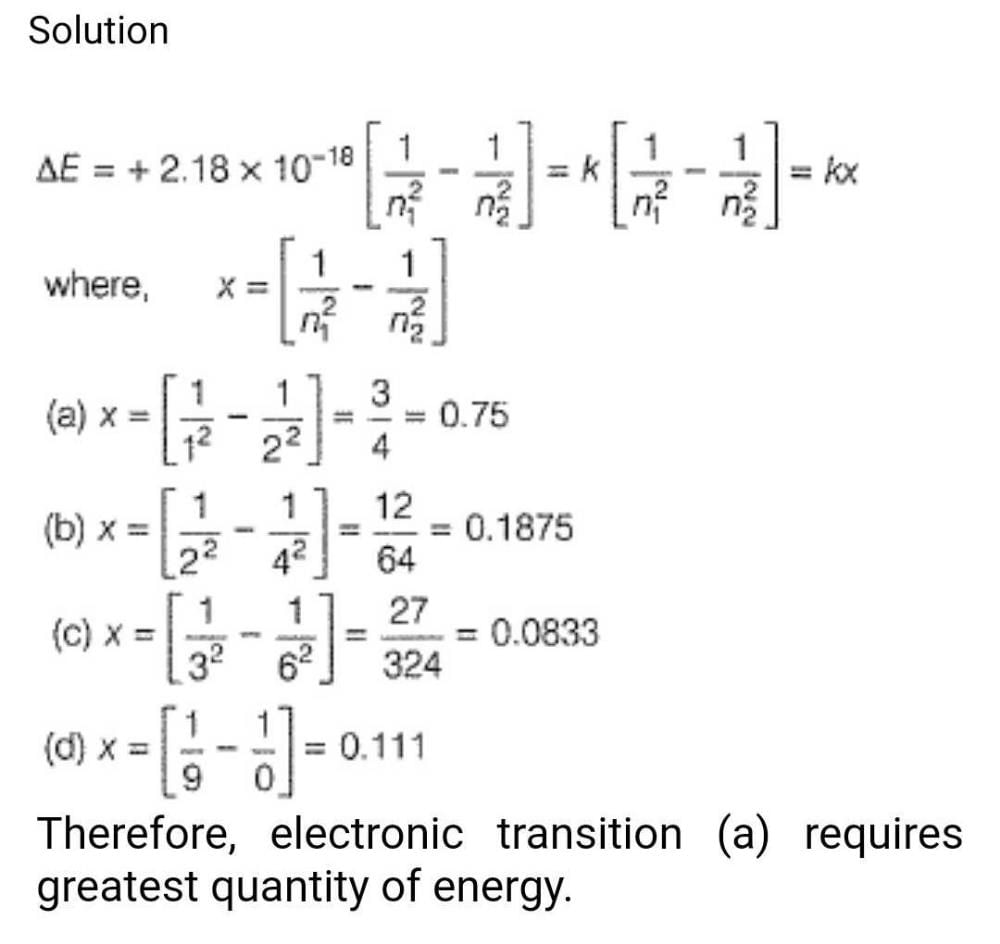Class 11 Exam > Class 11 Questions > Which of the following electronic transitions...
Start Learning for Free
Which of the following electronic transitions requires that the greatest quantity of energy be absorbed by a hydrogen atom ?
- a)n = 1 to n = 2
- b)n = 2 to n = 4
- c)n = 3 to n = 6
- d)n = 3 to n = ∞
Correct answer is option 'A'. Can you explain this answer?
Verified Answer
Which of the following electronic transitions requires that the greate...
Therefore, electronic transition (a) requires greatest quantity of energy.
Most Upvoted Answer
Which of the following electronic transitions requires that the greate...

Free Test
FREE
| Start Free Test |
Community Answer
Which of the following electronic transitions requires that the greate...
Explanation:
To determine which electronic transition requires the greatest quantity of energy to be absorbed by a hydrogen atom, we need to compare the energy differences between the initial and final states of each transition.
a) n = 1 to n = 2
In this transition, the electron moves from the first energy level (n = 1) to the second energy level (n = 2). The energy difference between these two levels is given by the equation:
ΔE = -13.6 eV * (1/1^2 - 1/2^2) = 10.2 eV
b) n = 2 to n = 4
In this transition, the electron moves from the second energy level (n = 2) to the fourth energy level (n = 4). The energy difference between these two levels is given by the equation:
ΔE = -13.6 eV * (1/2^2 - 1/4^2) = 3.4 eV
c) n = 3 to n = 6
In this transition, the electron moves from the third energy level (n = 3) to the sixth energy level (n = 6). The energy difference between these two levels is given by the equation:
ΔE = -13.6 eV * (1/3^2 - 1/6^2) = 2.7 eV
d) n = 3 to n = 5
In this transition, the electron moves from the third energy level (n = 3) to the fifth energy level (n = 5). The energy difference between these two levels is given by the equation:
ΔE = -13.6 eV * (1/3^2 - 1/5^2) = 1.7 eV
From the calculations, we can see that the transition from n = 1 to n = 2 requires the greatest quantity of energy to be absorbed by the hydrogen atom, with an energy difference of 10.2 eV. Therefore, the correct answer is option 'A'.

|
Explore Courses for Class 11 exam
|

|
Question Description
Which of the following electronic transitions requires that the greatest quantity of energy be absorbed by a hydrogen atom ?a)n = 1 to n = 2b)n = 2 to n = 4c)n = 3 to n = 6d)n = 3 to n = ∞Correct answer is option 'A'. Can you explain this answer? for Class 11 2025 is part of Class 11 preparation. The Question and answers have been prepared according to the Class 11 exam syllabus. Information about Which of the following electronic transitions requires that the greatest quantity of energy be absorbed by a hydrogen atom ?a)n = 1 to n = 2b)n = 2 to n = 4c)n = 3 to n = 6d)n = 3 to n = ∞Correct answer is option 'A'. Can you explain this answer? covers all topics & solutions for Class 11 2025 Exam. Find important definitions, questions, meanings, examples, exercises and tests below for Which of the following electronic transitions requires that the greatest quantity of energy be absorbed by a hydrogen atom ?a)n = 1 to n = 2b)n = 2 to n = 4c)n = 3 to n = 6d)n = 3 to n = ∞Correct answer is option 'A'. Can you explain this answer?.
Which of the following electronic transitions requires that the greatest quantity of energy be absorbed by a hydrogen atom ?a)n = 1 to n = 2b)n = 2 to n = 4c)n = 3 to n = 6d)n = 3 to n = ∞Correct answer is option 'A'. Can you explain this answer? for Class 11 2025 is part of Class 11 preparation. The Question and answers have been prepared according to the Class 11 exam syllabus. Information about Which of the following electronic transitions requires that the greatest quantity of energy be absorbed by a hydrogen atom ?a)n = 1 to n = 2b)n = 2 to n = 4c)n = 3 to n = 6d)n = 3 to n = ∞Correct answer is option 'A'. Can you explain this answer? covers all topics & solutions for Class 11 2025 Exam. Find important definitions, questions, meanings, examples, exercises and tests below for Which of the following electronic transitions requires that the greatest quantity of energy be absorbed by a hydrogen atom ?a)n = 1 to n = 2b)n = 2 to n = 4c)n = 3 to n = 6d)n = 3 to n = ∞Correct answer is option 'A'. Can you explain this answer?.
Solutions for Which of the following electronic transitions requires that the greatest quantity of energy be absorbed by a hydrogen atom ?a)n = 1 to n = 2b)n = 2 to n = 4c)n = 3 to n = 6d)n = 3 to n = ∞Correct answer is option 'A'. Can you explain this answer? in English & in Hindi are available as part of our courses for Class 11.
Download more important topics, notes, lectures and mock test series for Class 11 Exam by signing up for free.
Here you can find the meaning of Which of the following electronic transitions requires that the greatest quantity of energy be absorbed by a hydrogen atom ?a)n = 1 to n = 2b)n = 2 to n = 4c)n = 3 to n = 6d)n = 3 to n = ∞Correct answer is option 'A'. Can you explain this answer? defined & explained in the simplest way possible. Besides giving the explanation of
Which of the following electronic transitions requires that the greatest quantity of energy be absorbed by a hydrogen atom ?a)n = 1 to n = 2b)n = 2 to n = 4c)n = 3 to n = 6d)n = 3 to n = ∞Correct answer is option 'A'. Can you explain this answer?, a detailed solution for Which of the following electronic transitions requires that the greatest quantity of energy be absorbed by a hydrogen atom ?a)n = 1 to n = 2b)n = 2 to n = 4c)n = 3 to n = 6d)n = 3 to n = ∞Correct answer is option 'A'. Can you explain this answer? has been provided alongside types of Which of the following electronic transitions requires that the greatest quantity of energy be absorbed by a hydrogen atom ?a)n = 1 to n = 2b)n = 2 to n = 4c)n = 3 to n = 6d)n = 3 to n = ∞Correct answer is option 'A'. Can you explain this answer? theory, EduRev gives you an
ample number of questions to practice Which of the following electronic transitions requires that the greatest quantity of energy be absorbed by a hydrogen atom ?a)n = 1 to n = 2b)n = 2 to n = 4c)n = 3 to n = 6d)n = 3 to n = ∞Correct answer is option 'A'. Can you explain this answer? tests, examples and also practice Class 11 tests.

|
Explore Courses for Class 11 exam
|

|
Signup for Free!
Signup to see your scores go up within 7 days! Learn & Practice with 1000+ FREE Notes, Videos & Tests.



















